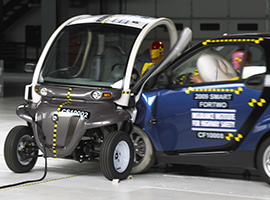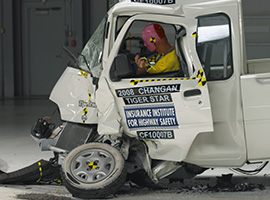Low-speed vehicles and minitrucks shouldn't share busy public roads with regular traffic
May 20, 2010
More states are allowing a relatively new breed of vehicle on public roads, but crash tests by the Insurance Institute for Highway Safety show why the mix of low-speed vehicles (LSVs) or minitrucks and regular traffic is a deadly combination. LSVs are designed for tooling around residential neighborhoods, and minitrucks are for hauling cargo off-road. While these vehicles have a lot of appeal as a way to reduce emissions and cut fuel use, they don't have to meet the basic safety standards that cars and pickups do, and they aren't designed to protect their occupants in crashes.
"By allowing LSVs and minitrucks on more and more kinds of roads, states are carving out exceptions to 40 years of auto safety regulations that save lives," says David Zuby, the Institute's chief research officer. "It's a troubling trend that flies in the face of the work insurers, automakers, and the federal government have done to reduce crash risk."
Practically every state allows LSVs, also called neighborhood electric vehicles, on certain roads, mostly with 35 mph or lower speed limits. Eight years ago just over a dozen states permitted them. Now 46 do. The National Highway Traffic Safety Administration (NHTSA) defines appropriate performance and safety standards but has no say in where LSVs are driven. The same goes for minitrucks, which are legal to operate on some roads in 16 states, even though they weren't designed to meet U.S. safety or emission standards. The trend to grant minitrucks access to regular roads began in 2007 and is growing at a quick pace.
"On one hand you have NHTSA saying these vehicles were meant for low-risk, controlled environments or farm use, and on the other hand states are pushing them out onto the highways," Zuby points out.
LSVs are essentially souped-up golf carts that were envisioned as a low-cost, eco-friendly way to tool around gated communities in the Sun Belt where they would have little interaction with larger vehicles. NHTSA doesn't require LSVs to have airbags or other safety features beyond belts since they're intended for low-risk driving. Most minitrucks in the United States are used right-hand-drive vehicles imported from Japan, where they can operate on roads as long as they pass inspection every 2 years. Vehicles that fail often end up exported to North America. Also known as Kei-class vehicles, minitrucks are smaller than conventional pickups and weigh about 1,500 pounds. They must be imported with governors to limit speeds to 25 mph or less to be exempt from Clean Air Act provisions but can go much faster.
NHTSA in 1998 established safety standards for LSVs to be used on "short trips for shopping, social, and recreational purposes primarily within retirement or other planned communities with golf courses." They must be able to go at least 20 mph but no faster than 25 mph. Basic features are required: headlights, taillights, stoplights, turn signals, reflectors, parking brakes, rearview mirrors, windshields, safety belts, and vehicle identification numbers.
Minitrucks weren't an issue when NHTSA wrote LSV rules. The agency in 2006 amended the standards to include vehicles with gross vehicle weight ratings up to 3,000 pounds, and now 4 states require minitrucks to meet LSV standards. Still, NHTSA believes minitrucks should keep off the road. In a July 2009 letter of interpretation, the agency said that because "these vehicles are not manufactured to meet U.S. safety standards, NHTSA cannot endorse their use on public highways."
The Energy Department estimates there are 45,000 LSVs on U.S. roads. New LSVs qualify for up to a $2,500 tax credit under the American Recovery and Reinvestment Act of 2009. Many states also offer tax incentives.
"Lost amid the talk about so-called sustainable transportation is any regard for the safety of people who ride in LSVs and minitrucks," Zuby says. "We're all for green vehicles that don't trade safety for fuel efficiency."
For eco-minded consumers, a better choice for regular traffic is a crashworthy hybrid like the Toyota Prius or another fuel-efficient car. Also worth a look are the Nissan Leaf and Chevrolet Volt, two battery-powered cars slated for delivery later this year.


Crash tests demonstrate risks
To show that LSVs and minitrucks are no match for even the smallest of regular cars and pickups, Institute researchers tested two GEM e2 electric vehicles and a Changan Tiger Star minitruck. The GEMs were in side tests, one using a moving deformable barrier and the other using a Smart Fortwo as the striking vehicle. The Smart is the smallest passenger vehicle on U.S. roads that meets crashworthiness standards. The Tiger struck a Ford Ranger XL regular cab pickup in a frontal offset test. The Ranger is one of the least pricey small pickups on the market. It earns an acceptable rating in the Institute's frontal crashworthiness test, the lowest rating in its vehicle class.
The test dummies in the GEMs and the Tiger recorded indications of seriously debilitating or fatal injury to drivers in real-world crashes. In contrast, the Smart performed well and the Ranger reasonably so in similar crash tests.
"There's a world of difference between vehicles that meet crashworthiness standards and those that don't," Zuby says. "It may be time for Congress to step in to extend federal passenger vehicle safety standards to LSVs or else restrict them to the low-risk traffic environments they were designed to navigate."
GEM side tests
The first GEM test was a side test in which a moving barrier representing a pickup or SUV crashes into the test vehicle at 31 mph. It's the most demanding test the Institute runs. Dummy measures suggest severe or fatal injury to a real person. In contrast, the Smart's airbags and safety cage protected the dummy from serious injury in an earlier side barrier test.
To show that the injury risk isn't only due to the aggressive barrier, a second test was run with a Smart crashing into a stationary GEM at 31 mph. The Smart's front intruded into the GEM's side so much that the belted dummy's head came close to hitting the Smart's windshield. The GEM dummy had injury measures indicating serious or fatal injury for real occupants.
"Watch the test footage, and it's obvious how devastating the side crash is to the GEM. It doesn't resist the crash forces at all," Zuby says. "GEMs and other LSVs weren't designed to protect people in a crash with a microcar like the Smart Fortwo, let alone larger cars, SUVs, and pickups in everyday traffic."
People in GEMs are protected by little more than safety belts and thermoplastic body panels. Doors are optional, though the crash-tested models had them. GEM e2 prices start at $7,395. They're made by Chrysler Group Global Electric Motorcars, the largest producer of low-speed electric vehicles. The company notes that its vehicles comply with LSV standards limiting maximum speeds to 25 mph and says customers typically drive GEMs on roads with speeds of 35 mph or less. It "recommends the operation of GEM vehicles within the standards set forth by NHTSA."
Frontal test of Tiger
The Institute conducted a frontal offset test between a 2008 Tiger Star minitruck going 25 mph and a 2010 Ranger going 35 mph. The Ranger has standard front and side airbags and electronic stability control. The Tiger has safety belts but no airbags. Without airbags, the Tiger driver dummy's head hit the steering wheel hard. Measures indicate the likelihood of serious neck injuries. In contrast, the Ranger dummy emerged unscathed.
The Tiger's outdated cab-forward design put the dummy's legs into the crush zone, resulting in severe injuries. The left leg and right foot were trapped by the clutch pedal and intruding structure. It's the kind of damage the Institute routinely saw when it began offset tests in 1995.
Unlike most minitrucks, Tiger Trucks are assembled with U.S. and foreign parts in Oklahoma. The company says its vehicles aren't intended for use on public roads and notes that some models meet LSV and emission standards. Minitrucks are fuel-efficient but not necessarily environmentally friendly since their classification as off-road vehicles exempts them from emission requirements. They run on gasoline, diesel, gasoline/ethanol blends, or battery power, depending on the model. Prices typically start at about $7,000-$8,000 and can go much higher.
For on-road driving, Zuby recommends consumers bypass minitrucks and spend more on a standard pickup to get crash protection and a vehicle that's OK to drive on all roads.